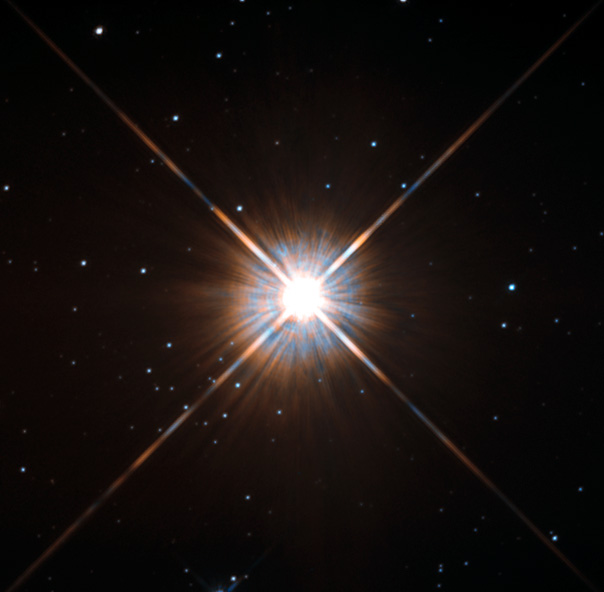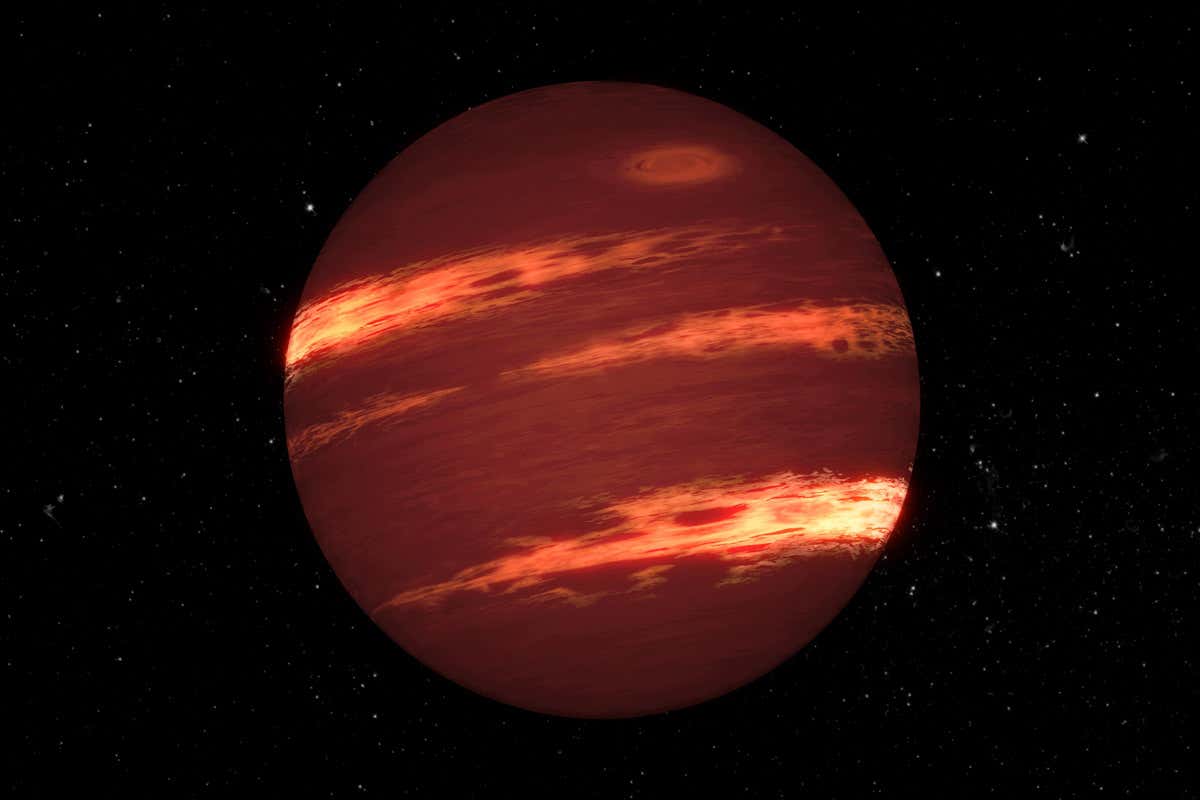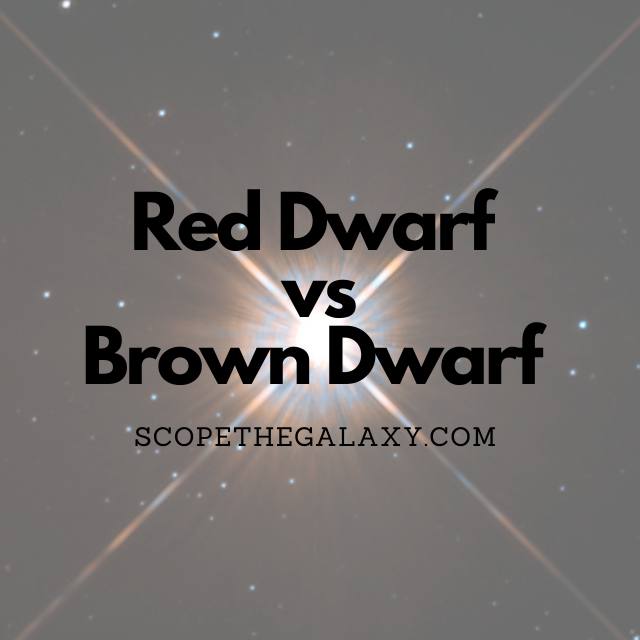*This post may contain affiliate links. This means we may make a commission if you purchase an item using one of our links*
Red dwarfs are the smallest and coolest kind of true stars, able to sustain nuclear fusion of normal hydrogen in their cores. Brown dwarfs, on the other hand, are substellar objects that lack the mass needed to fuse regular hydrogen, instead briefly burning deuterium (heavy hydrogen). This fundamental difference is why brown dwarfs are often called “failed stars.”
For a more detailed breakdown of both dwarf stars, including their similarities and other major differences, continue reading.
What Is A Red Dwarf?
Table of Contents

A Red Dwarf is a low-mass star that fuses hydrogen into helium in its core. Their low mass results in low pressures and temperatures, causing them to fuse fuel at a very slow and efficient rate. This efficiency gives them an astonishingly long lifespan, potentially reaching trillions of years. None are visible to the naked eye from Earth, yet they are the most common type of star in the universe, making up an estimated 75% of all stars in the Milky Way. Our closest stellar neighbor, Proxima Centauri, is a classic example of a red dwarf [Source: NASA Hubble].
These stars form in the same way as other stars, from the gravitational collapse of clouds of gas and dust. Once the core temperature and pressure are sufficient for hydrogen fusion, a red dwarf is born.
What Is A Brown Dwarf?

A Brown Dwarf represents one of the most fascinating “missing links” in astronomy, occupying the mysterious gap between the largest planets and the smallest stars. These substellar objects form like stars, from the gravitational collapse of clouds of gas and dust, but they never accumulate enough mass to ignite sustained hydrogen fusion—the process that defines a true star [Source: NASA Science].
The fundamental dividing line lies in mass. Astronomical classification defines brown dwarfs as objects with masses between 13 and 80 times the mass of Jupiter. The lower limit (∼13 MJup) is the minimum mass required to briefly fuse deuterium (heavy hydrogen), while the upper limit (∼75-80 MJup) is the minimum mass needed to sustain the fusion of regular hydrogen, which would make it a true red dwarf star [Source: ESA].
Because they cannot sustain hydrogen fusion, brown dwarfs lack a stable, long-term energy source. After their formation, they glow faintly from the residual heat of their gravitational contraction and from any brief deuterium fusion. Over time, they steadily cool and dim throughout their lives. This cooling process means their temperature range is incredibly wide, from nearly stellar temperatures of ~2,000°C (3,600°F) in their youth to temperatures colder than the freezing point of water for the oldest, coldest specimens, known as Y-dwarfs. In fact, NASA’s WISE telescope has identified brown dwarfs with atmospheric temperatures as low as 25°C (room temperature) [Source: NASA WISE Mission].
Astronomers classify brown dwarfs into spectral classes L, T, and Y based on their temperature and atmospheric chemistry. L-dwarfs are the hottest and can overlap with the smallest red dwarfs, while Y-dwarfs are the coldest and most planet-like. Their atmospheres are often filled with exotic features, including clouds of molten iron and silicate dust, as well as strong methane absorption bands, similar to the gas giant Jupiter.
Detecting them is a challenge precisely because they are so cool and dim. They emit most of their light in the infrared part of the spectrum. Space telescopes like NASA’s Spitzer (now decommissioned), WISE, and the James Webb Space Telescope are crucial tools for hunting these faint, cool objects by their heat signature rather than their visible light.
In essence, a brown dwarf is a permanent cosmic adolescent—it began the journey to stellarity but stalled out, destined to forever cool and fade, serving as a massive, link between the worlds of planets and stars. Their study provides critical insights into both stellar formation and the nature of giant exoplanets.
Similarities Between Red Dwarfs And Brown Dwarfs
- Both red dwarfs and brown dwarfs form from the gravitational collapse of gas and dust clouds within a nebula.
- Both are collectively categorized as “dwarf” stellar objects due to their small size relative to stars like our Sun.
- Both are difficult to observe with the naked eye and require powerful telescopes for study.
- Both can be orbited by planets, opening up questions about potential habitability in these extreme systems.
Differences Between Red Dwarfs And Brown Dwarfs
The differences between the two are significant and stem from their core physics:
- Stellar Status: Red dwarfs are true, hydrogen-fusing main sequence stars. Brown dwarfs are “failed stars” or substellar objects.
- Fusion Process: Red dwarfs fuse normal hydrogen. Brown dwarfs fuse deuterium for a short period (millions of years) and then cool indefinitely.
- Mass: Brown dwarfs are between 13 – 80 Jupiter masses. Red dwarfs are between 80 – 500 Jupiter masses (or 0.075 – 0.5 Solar Masses).
- Temperature: This is a key differentiator. Red dwarfs have surface temperatures between 2,000°C to 3,500°C. Brown dwarfs have a much wider and cooler range, from about 2,000°C when young down to below 0°C for the oldest and coldest ones [Source: NASA Science].
- Lifespan: Red dwarfs have theoretical lifespans of up to 10 trillion years. Brown dwarfs cool and fade over billions of years, but their deuterium fusion lasts only 1-100 million years.
- End State: Red dwarfs will eventually become white dwarfs after their unimaginably long lives. Brown dwarfs, having never been true stars, do not leave a stellar remnant; they simply become cold, dark planetary-mass objects.
- Brightness: Red dwarfs are dim but significantly brighter than brown dwarfs, which are extremely faint and primarily emit infrared radiation.
Summary
The main difference is fundamental: a red dwarf is an active star, while a brown dwarf is not. One is a “cosmic diesel engine,” built for incredible longevity, while the other is a “failed star” that fades into darkness. Red dwarfs are hot, long-lived, and common, while brown dwarfs are cool, fleeting in their youth, and exist as dark, massive objects. Despite sharing the “dwarf” name, they are defined by completely different physical processes and cosmic fates.
References
-
NASA Science: “What is a Brown Dwarf?”
https://science.nasa.gov/universe/what-is-a-brown-dwarf/ -
NASA Hubble: “Proxima Centauri”
https://hubblesite.org/contents/media/images/2013/20/3159-Image.html -
ESA: “Brown Dwarfs”
https://www.esa.int/Science_Exploration/Space_Science/Brown_dwarfs

